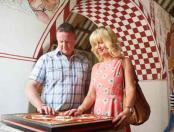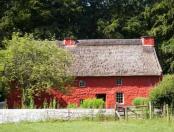Wales - South Wales
![]()
ST FAGANS NATIONAL MUSEUM OF HISTORY
 St Fagans,
St Fagans,
Cardiff
CF5 6XB
t: 0300 111 2 333
f: 00300 111 2444
e: post@museumwales.ac.uk
w: www.museumwales.ac.uk
Ever since it opened in 1948, St Fagans has been one of Europe’s leading open-air museums. Well loved by the people of Wales and tourists from all over the world, visitors can explore and enjoy Welsh history in over fifty original historic buildings that have been collected from all over Wales. The buildings show how the people of Wales have lived, worked, played and spent their leisure time through the ages. St Fagans has embarked on a major re-development programme to transform it into a flagship National History Museum for Wales, but will remain open to visitors throughout the project. In 2012, it was voted Britain’s ‘most-loved museum’ by readers of the popular consumer magazine Which?



Museum Highlights
Kennixton is a farmhouse from the Gower in South Wales dating from 1610. Its blood-red walls and carvings inside the front door were thought to ward off evil spirits.
Travel through time as you see six homes, their contents and gardens change from 1805 to 1985 at the Rhyd-y-Car Ironworkers' Houses.
Miners’ Institutes and Workmen’s Halls were once the focus of social, educational and cultural activity in some of the industrial areas of Wales. Oakdale Workman’s Institute offered a Library, Reading Room and Concert Hall, and was used by all manner of groups, clubs and societies. It’s easy to imagine the sights and sounds of dances, political lectures and even poultry shows which once took place there.
Explore the medieval St Teilo’s Church, built between 1100 and 1520, with its colourful wall paintings and beautiful wood carvings – a glimpse into Wales’s Catholic past
St Fagans Castle was originally built in 1580 and is set in formal gardens overlooking ornamental ponds. It is a Grade 1 listed building and one of the finest Elizabethan manor houses in Wales. The interior illustrates the history of the house throughout four centuries. As well as original furniture, some of the finest pieces from the Museum’s collections from other houses are also displayed.
Maestir School from Lampeter, West Wales was built in 1880. Children from five to fourteen were taught in the single classroom, drill and exercises took place in the yard.
Many working buildings have been relocated to the site, complete with traditional craftsmen still demonstrating their skills. The collection includes a fully working 19th century corn mill where the miller produces flour, a weaver working in an 18th century woollen mill, a blacksmith, and one of the last working clogmakers in Wales.
Essential Group Visit Info:
- FREE ENTRY
- Open all year, every day, 10am-5pm.
- Free coach parking on site.
- 10% discount for pre-booked group visitors in the museum shop, coffee shop and restaurant (minimum spend £5pp)
- Free refreshments for coach driver
- Wheelchair access throughout museum, but access to St Fagans Castle and some other buildings is via steep inclines.
- Allow at least half a day for your visit
- Located 4 miles west of Cardiff city centre and 5 minutes off the M4 motorway at junction 33. Due to close proximity, it’s easy to combine St Fagans and the National Museum Cardiff in a single day’s itinerary.


















